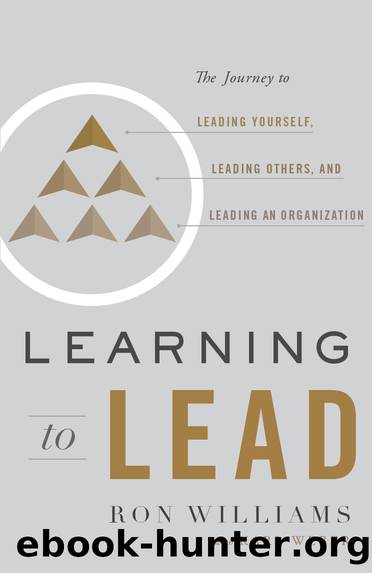Learning to Lead by Ron Williams

Author:Ron Williams
Language: eng
Format: epub
ISBN: 9781626346239
Publisher: Greenleaf Book Group Press
Published: 2019-03-14T16:00:00+00:00
DEFENDING THE PLAN: THE ACTION-FORCING EVENT
Once youâve developed a realistic plan that is driven by your organizationâs true priorities, you face the challenge of getting people to stick to the schedule. Somehow you need to ensure that the sense of importance that guided the conversation when you were planning the project remains in place during the days, weeks, or months it takes for the project to come to fruition.
One powerful tool for defending the plan is the action-forcing event. Iâve used this concept to help hundreds of projects with multiple participants stay on track and on time. The action-forcing event is a bit like a deadline. The major difference is that an action-forcing event involves a deliverable outcomeâa concrete, specifically defined work productâwhose timing is carefully and thoughtfully planned based on an analysis of the prior step. By contrast, most deadlines are set arbitrarily and with minimal thought, which is why they tend to be missed.
Suppose one of the action-forcing events in your project plan is the completion of an employee survey to determine the three most important functions that a proposed new internal company website should carry out. You could establish a date for this event by just plucking it from the airâbut thatâs a recipe for disappointment and delay. Instead, you need to work with the people who will be performing the required tasks to define precisely what needs to happen and how long each step will realistically take. In this case, the necessary steps might include the following:
â¢Step 1: Drafting the survey questionsâ3 working days
â¢Step 2: Having the survey content and format vetted and revised by experts in the HR departmentâ3 days
â¢Step 3: Making a list of employees and departments to be included in the survey and having the list okayed by the project directorâ3 days (simultaneous with Step 2)
â¢Step 4: Disseminating the survey to employees via emailâ1 day
â¢Step 5: Allowing time for employees to respond to survey; gathering and tabulating resultsâ5 days
â¢Step 6: Analyzing the results and writing a two-page report summarizing the key findingsâ3 days
The action-forcing event can only occur after all six steps have been completed. Since the time required for the steps totals fifteen working days, you can safely schedule the action-forcing event for three weeks from the starting date (assuming a standard work week of five days).
The number and kind of action-forcing events you should build into your project plan depend on the nature and complexity of the project. A huge project involving contributions from dozens or scores of people over six months or more may require ten to twenty action-forcing events, each carefully defined and assigned a particular target date. A smaller, simpler project may require only two or three action-forcing events. In both cases, the action-forcing events serve as milestones, driving the work schedule and triggering alarm bells whenever one or more events are missed.
As you can see, action-forcing events not only help to alert you when the project plan may be slipping, but they also focus the attention of
Download
This site does not store any files on its server. We only index and link to content provided by other sites. Please contact the content providers to delete copyright contents if any and email us, we'll remove relevant links or contents immediately.
Hit Refresh by Satya Nadella(9041)
The Compound Effect by Darren Hardy(8818)
Change Your Questions, Change Your Life by Marilee Adams(7638)
Nudge - Improving Decisions about Health, Wealth, and Happiness by Thaler Sunstein(7622)
The Black Swan by Nassim Nicholas Taleb(7016)
Deep Work by Cal Newport(6888)
Daring Greatly by Brene Brown(6451)
Rich Dad Poor Dad by Robert T. Kiyosaki(6414)
Principles: Life and Work by Ray Dalio(6226)
Playing to Win_ How Strategy Really Works by A.G. Lafley & Roger L. Martin(5937)
Man-made Catastrophes and Risk Information Concealment by Dmitry Chernov & Didier Sornette(5926)
Digital Minimalism by Cal Newport;(5667)
Big Magic: Creative Living Beyond Fear by Elizabeth Gilbert(5616)
The Myth of the Strong Leader by Archie Brown(5429)
The Slight Edge by Jeff Olson(5353)
Discipline Equals Freedom by Jocko Willink(5289)
The Motivation Myth by Jeff Haden(5158)
Stone's Rules by Roger Stone(5027)
The Laws of Human Nature by Robert Greene(5003)
